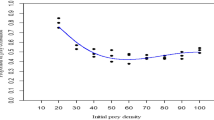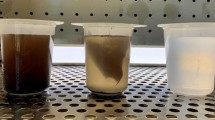Abstract
Toxorhynchites mosquitoes (Diptera: Culicidae), also known as elephant mosquitoes or mosquito eaters, are the largest mosquitoes globally and do not bite humans but prey on other mosquito larvae. We used a dip** and pipetting methods to collect larvae of Toxorhynchites spp. and Aedes mosquitoes from discarded tires. In a laboratory study, we investigated how container type, water volume, and depth affect the predation behavior of Toxorhynchites spp., and we also examined its predation efficiency during both day and night. Our research revealed that an individual Toxorhynchites spp. larva can consume up to 45 Aedes larvae, with mean predation of 25.18 (± 9.35) larvae in 24 h. Interestingly, predation rates and impacts remained consistent regardless of container type, water volume, or depth. While predation was more active during the day, there were no significant differences between daytime and nighttime predation abilities. These findings highlight Toxorhynchites spp. larvae as a promising biological control agent for mosquito management in various settings, independent of seasonal or light conditions, especially for the Aedes spp.




Similar content being viewed by others
Change history
17 June 2024
A Correction to this paper has been published: https://doi.org/10.1007/s10526-024-10270-5
References
Albeny-Simões D, Murrell EG, Elliot SL, Andrade MR, Lima E, Juliano SA, Vilela EF (2014) Attracted to the enemy: Aedes aegypti prefers oviposition sites with predator-killed conspecifics. Oecologia 175:481–492
Collins LE, Blackwell A (2000) The biology of Toxorhynchites mosquitoes and their potential as biocontrol agents. BNI 21(4):105–116
Darsie RF, Courtney GW, Pradhan SP (1996) Notes on the mosquitoes of Nepal IV: results of the 1994 collecting in the midwestern region, including new country records and voucher confirmation (Diptera: Culicidae). J Am Mosq Control Assoc 12(1):130–134
Digma JR, Sumalde AC, Salibay CC (2019) Laboratory evaluation of predation of Toxorhynchites amboinensis (Diptera: Culicidae) on three mosquito vectors of arboviruses in the Philippines. Biol Control 137:104009
Dominic AD, Das P (1998) Estimation of predation by the larvae of Toxorhynchites splendens on the aquatic stages of Aedes aegypti. Southeast Asian J Trop Med and Public Health 29(1):177–183
Donald CL, Siriyasatien P, Kohl A (2020) Toxorhynchites species: a review of current knowledge. Insects 11:747
Ebi KL, Nealon J (2016) Dengue in a changing climate. Environ Res 151:115–123
ECDC. 2023. Dengue worldwide overview. Dengue worldwide overview. https://www.ecdc.europa.eu/en/dengue-monthly (accessed 26 Dec 2023).
Focks DA (2007) Toxorhynchites as biocontrol agents. J Am Mosq Control Assoc 23(sp2):118–127
Frank JH, Curtis GA, O’Meara GF (1984) On the bionomics of bromeliad-inhabiting mosquitoes X. Toxorhynchites r. rutilus as a predator of Wyeomyia vanduzeei (Diptera: Culicidae). J Med Entomol 21(2):149–158
Harbach RE. 2024. Valid species | Mosquito taxonomic inventory. Mosquito taxonomic inventory. https://mosquito-taxonomic-inventory.myspecies.info/valid-species-list (accessed 19 Jan 2024).
Hawkes FM, Hopkins RJ (2022) The mosquito: An introduction. In: Hall M, Tamir D (eds) Mosquitopia: The place of pests in a healthy world. Routledge, New York, pp 16–31
Haynes DM (2001) Imperial medicine: Patrick Manson and the conquest of tropical disease. University of Pennsylvania Press
Higa Y (2011) Dengue vectors and their spatial distribution. Trop Med Health 39(sp4):17–27
Kraemer MU, Sinka ME, Duda KA, Mylne AQ, Shearer FM, Barker CM, Moore CG, Carvalho RG, Coelho GE, van Bortel W, Hendrickx G, Schaffner F, Elyazar IR, Teng H-J, Brady OJ, Messina JP, Pigott DM, Scott TW, Smith DL, Wint GW, Golding N, Hay SI (2015) The global distribution of the arbovirus vectors Aedes aegypti and Ae. albopictus. Elife 4:e08347
Malla RK, Mandal KK, Burman S, Das S, Ghosh A, Chandra G (2023) Numerical analysis of predatory potentiality of Toxorhynchites splendens against larval Aedes albopictus in laboratory and semi-field conditions. Sci Rep 13:7403
Manson-bahr P (1962) Patrick Manson. The father of tropical medicine. Thomas Nelson and Sons Ltd., UK
Mercer DR, Wettach GR, Smith JL (2005) Effects of larval density and predation by Toxorhynchites amboinensis on Aedes polynesiensis (Diptera: Culicidae) develo** in coconuts. J Am Mosq Control Assoc 21(4):425–431
Millado JBH, Sumalde AC (2018) Voracity and prey preference of philippine population of Toxorhynchites splendens Wiedemann (Diptera: Culicidae) among Aedes spp (Diptera: Culicidae) and Culex quinquefasciatus Say (Diptera: Culicidae). Southeast Asian J Trop Med Public Health 49(2):1–11
Mohamad N, Zuharah WF (2014) Influence of container design on predation rate of potential biocontrol agent, Toxorhynchites splendens (Diptera: Culicidae) against dengue vector. Trop Biomed 31(1):166–173
Mordecai EA, Ryan SJ, Caldwell JM, Shah MM, LaBeaud AD (2020) Climate change could shift disease burden from malaria to arboviruses in Africa. Lancet Planet Health 4(9):e416–e423
Muhamat M, Hadisusanto S, Umniyati SR, Soesilohadi RCH (2022) Predation ability Toxorhynchites splendens larvae from Banjarbaru. IOP Conference Series: Earth and Environmental Science 976:012011
Naish S, Dale P, Mackenzie JS, McBride J, Mengersen K, Tong S (2014) Climate change and dengue: a critical and systematic review of quantitative modelling approaches. BMC Infect Dis 14:167
Nyamah MA, Sulaiman S, Omar B (2011) Field observation on the efficacy of Toxorhynchites splendens (Wiedemann) as a biocontrol agent against Aedes albopictus (Skuse) larvae in a cemetery. Trop Biomed 28(2):312–319
Padgett PD, Focks DA (1981) Prey stage preference of the predator, Toxorhynchites rutilus rutilus on Aedes aegypti. Mosq News 41(1):67–70
Peters W, Dewar S (1956) A preliminary record of the megarhine and culicine mosquitoes of Nepal with notes on their taxonomy (Diptera: Culicidae). Indian J Malariol 10(1):37–51
Phasomkusolsil S, Chaiyasap M, Tawong J, Kornkan T, Jitbantrengphan T, Monkanna N, Lindroth EJ (2022) Laboratory studies of oviposition site choice of Toxorhynchites splendens: role of larval holding-rearing water and predator-prey interactions. Acta Trop 235:106664
Ross R. 2024. Ronald Ross biographical. NobelPrize.org. https://www.nobelprize.org/prizes/medicine/1902/ross/biographical/ (accessed 19 Jan 2024).
Russell PK, Gould DJ, Yuill TM, Nisalak A, Winter PE (1969) Recovery of dengue-4 viruses from mosquito vectors and patients during an epidemic of dengue hemorrhagic fever. Am J Trop Med and Hyg 18(4):580–583
Russo R (1986) Comparison of predatory behavior in five species of Toxorhynchites (Diptera: Culicidae). Ann Entomol Soc Am 79(4):715–722
Schiller A, Allen M, Coffey J, Fike A, Carballo F (2019) Updated methods for the production of Toxorhynchites rutilus septentrionalis (Diptera, Culicidae) for use as biocontrol agent against container breeding pest mosquitoes in Harris County. Texas. J Insect Sci 19(2):8
Sinden RE (2007) Malaria, mosquitoes and the legacy of Ronald Ross. Bull World Health Organ 85(11):894–896
Smith CG (1956) The history of dengue in tropical Asia and its probable relationship to the mosquito Aedes aegypti. J Trop Med Hyg 59(10):243–251
Steffan WA, Evenhuis NL (1981) Biology of Toxorhynchites. Ann Rev Entomol 26:159–181
Sukupayo PR, Poudel RC, Ghimire TR (2024) A systematic review on the distribution and density of Aedes species in the Hindu-Kush Himalayan countries. Indian J Entomol. e24392. https://doi.org/10.55446/IJE.2024.1392
Tandina F, Doumbo O, Yaro AS, Traoré SF, Parola P, Robert V (2018) Mosquitoes (Diptera: Culicidae) and mosquito-borne diseases in Mali. West Africa Parasites & Vectors 11:467
Tedjou AN, Kamgang B, Yougang AP, Wilson-Bahun TA, Njiokou F, Wondji CS (2020) Patterns of ecological adaptation of Aedes aegypti and Aedes albopictus and Stegomyia indices highlight the potential risk of arbovirus transmission in Yaoundé, the capital city of Cameroon. Pathogens 9:491
Tippelt L, Werner D, Kampen H (2020) Low temperature tolerance of three Aedes albopictus strains (Diptera: Culicidae) under constant and fluctuating temperature scenarios. Parasit Vectors 13:587
Trpis M (1972) Development and predatory behavior of Toxorhynchites brevipalpis (Diptera: Culicidae) in relation to temperature. Environ Entomol 1(5):537–546
Tyagi BK, Munirathinam A, Krishnamoorthy R, Baskaran G, Govindarajan R, Krishnamoorthi R, Mariappan T, Dhananjeyan KJ, Venkatesh A (2015) A revision of genus Toxorhynchites Theobald, 1901, in the South-East Asian countries, with description of a new species Toxorhynchites (Toxorhynchites) darjeelingensis from West Bengal, India (Diptera: Culicidae). Halteres 6:13–32
Vinogradov DD, Sinev AY, Tiunov AV (2022) Predators as control agents of mosquito larvae in micro-reservoirs (Review). Inland Water Biol 15(1):39–53
Watts RB, Smith SM (1978) Oogenesis in Toxorhynchites rutilus (Diptera: Culicidae). Can J Zool 56:136–139
WHO (2012) Global strategy for dengue prevention and control 2012–2020. World Health Organization, Geneva
Yee D. (2022). Less than 10% of mosquito species spread human disease. Entomology Today. https://entomologytoday.org/2022/07/26/less-than-10-percent-mosquito-species-spread-human-disease/ (accessed 7 Nov 2023).
Zuharah WF, Fadzly N, Yusof NA, Dieng H (2015) Risky behaviors: Effects of Toxorhynchites splendens (Diptera: Culicidae) predator on the behavior of three mosquito species. J Insect Sci 15(1):128
Zuharah WF, Sumayyah A (2019) Population abundance of Aedes albopictus and Culex quinquefasciatus in 24 hours cycle in residential areas, Penang using different trap** methods. Serangga 24(1):17–41
Acknowledgements
We express our gratitude to Nirmal Bajracharya for assisting in the statistical analysis. We extend our appreciation to the Central Department of Zoology, Tribhuvan University, Bhaktapur Multiple Campus, Tribhuvan University, and the Nepal Academy of Science and Technology for providing research opportunity. We acknowledge the local government authorities and residents of the study areas for their consistent support during the field survey.
Funding
This research received no specific grant from any funding agency in the public, commercial or not-for-profit sectors.
Author information
Authors and Affiliations
Contributions
Punya Ram Sukupayo (conceptualization-lead, data curation-lead, formal analysis-lead, investigation-lead, methodology-lead, validation-lead, visualization-lead, writing–original draft-lead, writing–review and editing-lead), Ram Chandra Poudel (conceptualization-supporting, supervision-supporting, validation-supporting, writing–original draft-supporting, writing–review and editing-supporting), Tirth Raj Ghimire (conceptualization-supporting, supervision-supporting, writing–original draft-supporting, writing–review and editing-supporting). All authors read and finalized the submission.
Corresponding authors
Ethics declarations
Conflict of interest
The authors have no financial or proprietary interests in any material discussed in this article.
Research involving human and animal rights
The study did not involve human participants and/or vertebrate animals.
Informed consent
The study contains no individual person’s data in any form. Informed consent is not applicable.
Additional information
Handling Editor: Marta Montserrat.
The online original version of this article was revised: the author list was originally published as Punya Ram Sukupayo, Ram Chandra Poudel, Tirth Raj Ghimire and Eric Wajnberg, when it should have been Punya Ram Sukupayo, Ram Chandra Poudel and Tirth Raj Ghimire
Rights and permissions
Springer Nature or its licensor (e.g. a society or other partner) holds exclusive rights to this article under a publishing agreement with the author(s) or other rightsholder(s); author self-archiving of the accepted manuscript version of this article is solely governed by the terms of such publishing agreement and applicable law.
About this article
Cite this article
Sukupayo, P.R., Poudel, R.C. & Ghimire, T.R. Predatory behavior and potentiality of Toxorhynchites spp. (Diptera: Culicidae) against Aedes mosquito. BioControl 69, 387–395 (2024). https://doi.org/10.1007/s10526-024-10267-0
Received:
Accepted:
Published:
Issue Date:
DOI: https://doi.org/10.1007/s10526-024-10267-0




